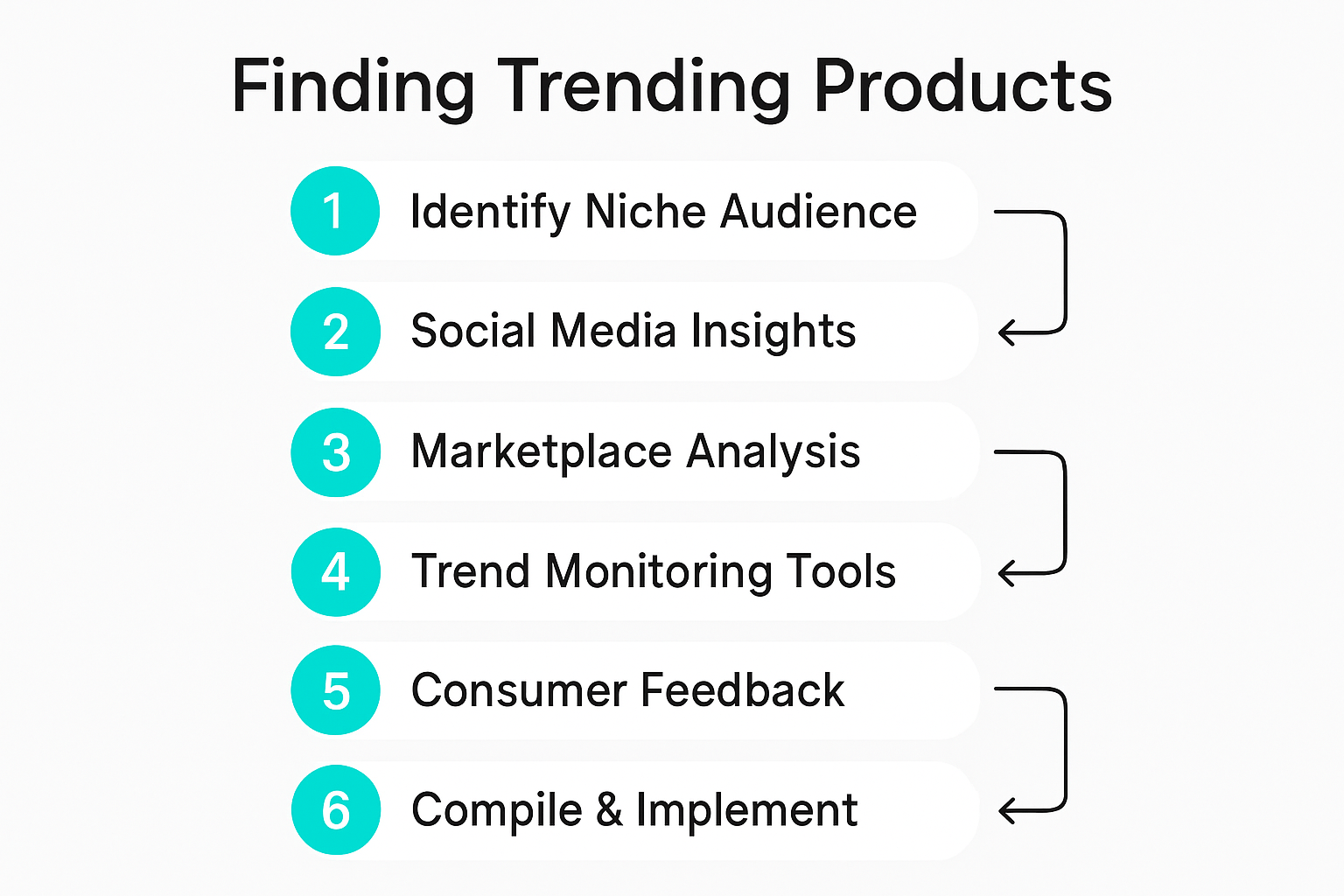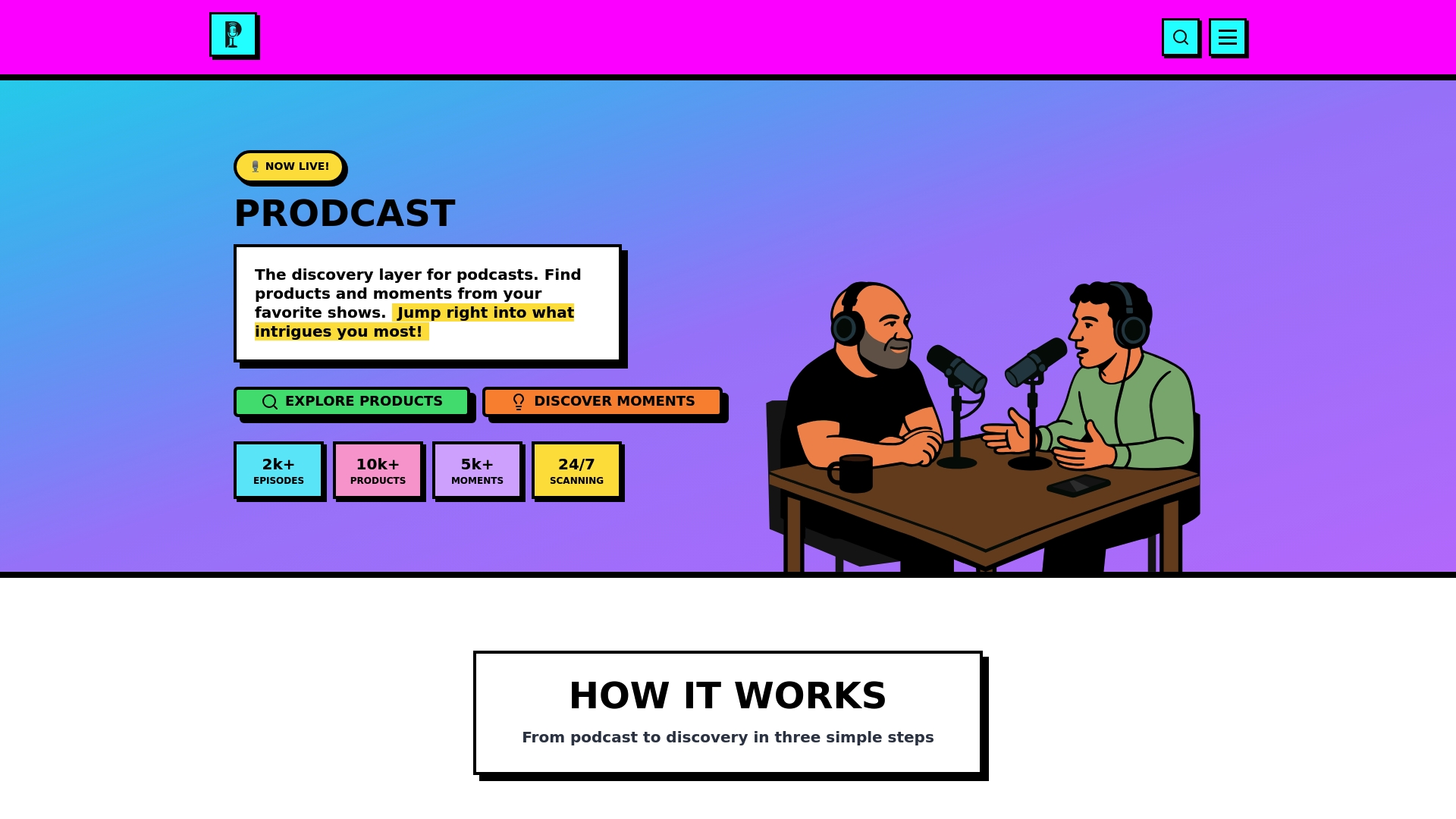CATEGORIES
TAGS
How to Find Trending Products for 2025: A Step-by-Step Guide

Discovering trending products can seem overwhelming when online marketplaces churn through thousands of new items every day. But less than 5 percent of new products ever become top sellers, leaving everyone else scrambling to catch up. The real secret does not lie in chasing the hottest item, but in finding hidden patterns that only careful research and a sharp eye for emerging trends can reveal.
Table of Contents
Quick Summary
Key PointExplanation1. Identify a Specific Niche MarketFocus on understanding a targeted audience’s needs and purchasing habits for successful product discovery.2. Utilize Social Media for InsightsMonitor social platforms to uncover real-time consumer insights and emerging product trends that may not yet be mainstream.3. Analyze Online Marketplaces for TrendsStudy best-seller lists and customer reviews on platforms like Amazon to validate potential trending products.4. Validate with Genuine Consumer FeedbackEngage directly with your target audience through surveys and discussions to confirm or challenge trend hypotheses.5. Compile Data into a Strategic FrameworkSynthesize all collected findings into a centralized system to guide product discovery and decision-making effectively.

Step 1: Identify Your Niche Market and Audience
Successful product discovery starts with understanding precisely who you want to serve. Your ability to find trending products hinges on pinpointing a specific audience with clear needs and purchasing behaviors. Think of this step as creating a detailed map before embarking on a journey through the complex landscape of product trends.
Begin by conducting comprehensive market research that goes beyond surface-level demographics. You need to understand not just who your potential customers are, but what drives their purchasing decisions. Analyze online communities, forums, social media groups, and platforms like Reddit where passionate niche audiences discuss their interests and pain points. Tools like Google Trends can provide invaluable insights into emerging interests and search behaviors across different market segments.
Dig deeper by examining consumer behavior patterns. Look for emerging communities with passionate engagement and discretionary spending power. Pay attention to micro-trends within specific interest groups, whether it’s urban gardening enthusiasts, remote work professionals, fitness technology adopters, or sustainable living advocates. Each of these niches represents potential goldmines for discovering products that solve real problems.
To validate your market research, create a detailed audience persona that encompasses key characteristics:
Age range and generational characteristics
Disposable income levels
Primary interests and passion points
Online platforms and communities they frequent
Specific pain points or unmet needs
Verify your market identification by cross-referencing multiple data sources. Check keyword search volumes, analyze social media engagement metrics, and review emerging product categories on platforms like Amazon and Kickstarter. Success in finding trending products requires a combination of strategic research, keen observation, and the ability to spot opportunities before they become mainstream.
Remember that identifying your niche is not about finding the largest possible market, but the most engaged and underserved audience. The more precisely you can define your target market, the more effectively you can discover products that will resonate strongly with their specific needs and desires.
Step 2: Utilize Social Media Platforms for Insights
Social media platforms are treasure troves of real-time consumer insights, offering unprecedented access to emerging trends and product interests. By strategically navigating these digital landscapes, you can uncover valuable information about potential trending products before they hit mainstream markets. Your goal is to transform social media from a casual browsing experience into a systematic trend detection method.
Start by creating dedicated monitoring streams across multiple platforms. Instagram and TikTok are particularly powerful for visual trend detection, where hashtag research and content analysis can reveal rapidly emerging product interests. Use tools like Hootsuite or Sprout Social to track specific hashtags, keywords, and engagement metrics related to your identified niche market.
Dive deep into niche communities and subgroups where passionate consumers discuss their interests. Reddit threads, Facebook Groups, and specialized forums offer unfiltered conversations about product desires, pain points, and emerging solutions. Pay close attention to posts with high engagement rates, recurring discussion themes, and comments expressing frustration with current product offerings. These are often indicators of potential market opportunities waiting to be addressed.
To maximize your trend detection, create a systematic approach to social media research:
Follow industry influencers and thought leaders in your chosen niche
Set up keyword alerts for emerging product categories
Analyze comment sections for genuine consumer feedback
Track viral content related to product recommendations
Leverage advanced social listening techniques by examining not just what people are saying, but how they are saying it. Sentiment analysis can reveal underlying consumer emotions and unmet needs that translate directly into product opportunities. Look for patterns of excitement, frustration, or anticipation that signal potential market gaps.
Verify your findings by cross-referencing social media insights with other research methods. A trend identified on social platforms gains credibility when supported by additional data points from market research, search trends, and consumer behavior analytics. Remember that successful trend identification is about recognizing signals before they become obvious to everyone.
Step 3: Analyze Online Marketplaces for Best Sellers
Online marketplaces are goldmines of real-time product trend information, offering unparalleled insights into what consumers are actually purchasing. Your objective in this step is to transform marketplace data into strategic intelligence about emerging and successful product categories. By systematically analyzing best-seller lists, you can uncover hidden opportunities and validate potential trending products before significant market saturation.
Start with comprehensive marketplace exploration across platforms like Amazon, eBay, and Etsy. Each marketplace offers unique insights into different consumer segments and product niches. Amazon’s Best Sellers list is particularly valuable, providing near-real-time data on top-performing products across numerous categories. Use tools like Jungle Scout or Helium 10 to dive deeper into sales rank, pricing, and historical performance metrics.
Don’t just look at current best-sellers; analyze the trajectory of product performance. Pay attention to products experiencing rapid growth, sudden popularity spikes, or consistent upward sales trends. These indicators often signal emerging market opportunities before they become mainstream. Examine customer reviews meticulously, looking for recurring themes about product strengths, limitations, and unmet consumer needs.
To maximize your marketplace research effectiveness, develop a systematic approach:
Track sales ranks across multiple categories
Analyze price points and profit margins
Examine customer review sentiment
Identify products with consistent but not saturated demand
Expand your research beyond traditional e-commerce platforms. Emerging marketplaces like Wish, AliExpress, and regional platforms can offer early insights into product trends that haven’t yet penetrated major markets. Look for products solving specific problems or addressing unique consumer pain points, as these often represent the most promising opportunities.
Verify your findings by cross-referencing marketplace data with your previous research from social media and niche market analysis. A product trend becomes truly promising when it demonstrates consistent performance across multiple platforms and aligns with your identified target audience’s needs. Remember that successful trend identification requires patience, systematic observation, and the ability to recognize potential before it becomes obvious to everyone.
Step 4: Monitor Trend Analysis Tools and Resources
Successful trend identification requires leveraging sophisticated digital tools that transform raw data into actionable insights. Your mission is to build a comprehensive trend monitoring system that provides real-time intelligence about emerging product opportunities. By strategically selecting and utilizing trend analysis resources, you can gain a competitive edge in identifying potential market trends before they become mainstream.
Begin by investing in powerful trend monitoring platforms that aggregate data from multiple sources. Google Trends offers a free and powerful starting point, allowing you to track search volume and geographical interest for specific keywords and product categories. Complement this with more advanced tools like Trend Hunter, which provides curated trend reports and innovative market insights across various industries.
Expand your trend detection arsenal by incorporating specialized tools that offer deep market intelligence. Platforms like Exploding Topics use advanced algorithms to identify emerging trends before they hit mainstream awareness. These tools analyze web traffic, social media mentions, and search patterns to highlight products and concepts experiencing rapid growth. The key is not just collecting data, but understanding the narrative and potential behind emerging trends.
Develop a systematic approach to trend monitoring that includes multiple intelligence sources:
Subscribe to industry-specific newsletters and trend reports
Follow innovative research institutions and think tanks
Set up automated alerts for keywords in your target niche
Participate in online communities discussing emerging technologies
Remember that trend analysis is not a one-time activity but an ongoing process of continuous learning and adaptation. Allocate dedicated time each week to review your trend monitoring tools, analyze new insights, and adjust your product discovery strategy accordingly. Cross-reference information from multiple sources to validate potential trends and reduce the risk of false positives.
Verify the effectiveness of your trend monitoring approach by tracking the accuracy of your predictions and the relevance of identified trends to your specific market niche. Success in trend detection comes from combining technological tools with human intuition and deep market understanding.
Step 5: Validate Trends with Consumer Feedback
Validating product trends requires direct engagement with potential consumers, transforming theoretical market research into tangible insights. Your goal is to move beyond data analysis and hear authentic voices that can confirm or challenge your trend hypotheses. Consumer feedback serves as the critical bridge between market potential and actual product viability.
Initiate your validation process by creating targeted surveys and focus groups specifically designed to explore the potential of your identified trends. Platforms like SurveyMonkey and UserTesting enable you to quickly gather structured feedback from demographic groups matching your target market. Craft questions that go beyond simple product preferences, exploring deeper motivations, pain points, and potential use cases that might not be immediately apparent from initial trend research.
Expand your feedback collection strategy by actively engaging with online communities related to your potential product trends. Reddit forums, Facebook Groups, and specialized online discussion boards offer unfiltered insights into consumer sentiments. Pay close attention to not just positive comments, but also critiques and hesitations that might reveal critical product development considerations. The most valuable feedback often comes from understanding potential barriers to adoption.
Establish a comprehensive feedback validation approach:
Create multi-channel feedback collection methods
Develop nuanced survey questions targeting specific trend aspects
Incentivize detailed, honest consumer responses
Cross-reference feedback from multiple consumer segments
Utilize advanced sentiment analysis tools to process large volumes of consumer feedback systematically. Look for consistent themes, emotional responses, and underlying needs that might not be immediately obvious. Remember that consumer feedback is not just about confirming trends, but understanding the deeper psychological and practical motivations driving potential product interest.
Verify the validity of your trend research by achieving a consistent level of positive consumer interest across different feedback channels. Successful trend validation occurs when multiple independent consumer groups demonstrate genuine excitement and practical use cases for the potential product. Treat consumer feedback as a dynamic, ongoing conversation that continuously refines your understanding of market opportunities.
Step 6: Compile and Implement Your Findings
Transforming your extensive research into actionable insights requires a strategic and systematic approach. Your goal is to synthesize all collected data into a comprehensive trend analysis framework that guides future product discovery decisions. This final step bridges the gap between research and practical implementation, turning raw information into a strategic roadmap for identifying trending products.
Below is a summary table of key digital tools and platforms you can use during each step of the trend discovery process, along with their primary purpose.
Tool/ResourceStep UsedPurposeGoogle TrendsIdentify Niche; Monitor TrendsTrack search volume & emerging keyword interestsHootsuite / Sprout SocialSocial Media InsightsMonitor hashtags, keywords, & engagement on socialReddit/Facebook GroupsIdentify Niche; Consumer ValidationExplore niche discussions & gather authentic feedbackJungle Scout / Helium 10Analyze MarketplacesAnalyze sales ranks, pricing, & product performanceTrend HunterMonitor TrendsAccess curated trend reports & innovative insightsExploding TopicsMonitor TrendsDetect emerging topics & rapidly growing trendsSurveyMonkey / UserTestingValidate TrendsGather direct consumer feedbackNotion / AirtableCompile/Implement FindingsCentralize findings, organize research, & scoring
Begin by creating a centralized research repository using collaborative tools like Notion or Airtable. Organize your findings across multiple dimensions: market potential, consumer feedback, trend trajectory, and potential challenges. Develop a scoring system that allows you to objectively compare and prioritize different product trends, ensuring your selection process remains data-driven and systematic.
Establish a rigorous method for interpreting and ranking your research findings. Look beyond surface-level data to understand the underlying consumer motivations, technological shifts, and market dynamics driving each potential trend. Successful implementation requires seeing beyond individual data points to recognize broader market narratives and emerging consumer needs. Create visual representations like trend maps and correlation charts that help you and your team understand the interconnected nature of your research insights.
Develop a structured approach to trend implementation:
Create a weighted scoring system for trend evaluation
Establish clear criteria for trend potential
Design regular review and update mechanisms
Build flexibility into your trend identification process
Implement a continuous learning and iteration cycle that allows you to refine your trend identification methodology. Schedule quarterly reviews of your research methodology, analyzing the accuracy of previous predictions and identifying areas for improvement. This approach transforms trend research from a static process into a dynamic, evolving strategy that adapts to changing market conditions.
Verify the effectiveness of your findings by tracking the conversion rate of identified trends into successful product opportunities. True success in trend identification is not just about spotting potential, but consistently translating those insights into actionable business strategies. Maintain a feedback loop that connects your trend research directly to product development, marketing strategies, and business innovation efforts.

Here is a checklist to help you verify your trend discovery process at each stage. Use this table to ensure all important tasks are completed before moving to the next step.
StepVerification TaskCriteria for CompletionIdentify Niche MarketCreated detailed audience personaPersona includes demographics, needsSocial Media InsightsCross-referenced platforms and keyword alertsMultiple trends show engagementAnalyze MarketplacesCompared best-sellers and review sentimentTrends align with target audienceMonitor Trend ToolsSet up alerts and reviewed multiple sourcesConsistent signals across sourcesValidate with FeedbackCollected surveys and monitored discussionPositive & actionable user feedbackCompile & ImplementDeveloped weighted scoring and trend reviewsStrategic roadmap completed
Stop Guessing and Start Discovering Tomorrow’s Trends—Effortlessly
Are you tired of spending endless hours trying to uncover trending products, only to find competitors have already saturated the market? The article shows how challenging it is to sort through data, monitor social channels, and validate trends before taking action. If you want to stay ahead for 2025, you need more than just research—you need real-time insights delivered as soon as new products hit the conversation.

Imagine automatically accessing the hottest product mentions directly from thousands of top podcasts, all meticulously categorized and linked for instant buying. Prodcast uses advanced AI to spotlight exactly what’s trending at the source, transforming your product discovery routine into a dynamic, data-driven process.
Ready to turn trendspotting into profit? Join a community of forward-thinking entrepreneurs and experience the smartest way to spot, showcase, and shop the next wave of bestsellers. Start discovering on Prodcast today. If you want to become a vendor and get your products in front of engaged listeners, you can explore how to get started right on our main site.
Frequently Asked Questions
How can I identify my niche market for product trends?
To identify your niche market, conduct comprehensive market research focusing on specific audience needs and purchasing behaviors. Analyze online communities, consumer forums, and platforms like Google Trends to understand emerging interests and pain points within your target audience.
What social media platforms are best for uncovering product trends?
Platforms like Instagram and TikTok excel at revealing visual product trends. You can use tools like Hootsuite and Sprout Social to track relevant hashtags and engagement metrics within your niche market.
How do I validate a trending product idea?
Validation can be done by gathering direct consumer feedback through surveys and focus groups. Utilize platforms like SurveyMonkey to ask targeted questions and engage with online communities to understand consumer sentiments about your product trend.
What tools should I use to analyze marketplace product data?
Utilize tools like Jungle Scout and Helium 10 to analyze sales ranks, pricing, and historical performance metrics on online marketplaces. These tools help uncover top-performing products and emerging opportunities based on real-time data.